Nimue Brown's Blog, page 324
April 23, 2016
Walking the Rainbow Path
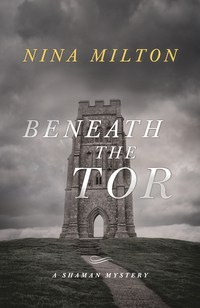 A guest blog, by
Nina Milton
A guest blog, by
Nina Milton
One sunny autumn morning, fifteen years ago, I shipped up in Bath, to attend an introductory workshop on shamanism. As a druid, I was used to enjoying guided visualisations and wanted to know more about what happens when you stop being ‘guided’ and sink deeply into a trance that takes you away from everything around you. I’d started reading about shamanism; books like The Teachings of Don Juan, by Carlos Castaneda, Cave and Cosmos, by Michael Harner and Your Shamanic Path, by Leo Rutherford, showed me that shamanism was a historic world-wide phenomenon, but also that it still thrives today.
I’m an OBOD a druid, so it was British shamanism I was most attracted to. It uses archetypes I already knew from the Celtic myths, comforting symbols such as cauldrons and oak trees, and did not depend on mind-altering drugs to attain a state of trance. I’d consumed a lot of books by Caitlin and John Matthews, especially The Celtic Shaman and Singing the Soul back Home, but books a shaman maketh not; and here I was, sitting on a floor cushion alongside thirty other people, waiting for John Matthews to introduce us to this magical place. He looked ordinary, sitting cross-legged between us, and he opened the workshop in a quiet, almost muted voice.
“I’d better warn you now,” he said, without drama. “Shamanism will alter your life.”
Although I was keen – really keen – I’d paid money to be here – I couldn’t help thinking…’yeah, right’.
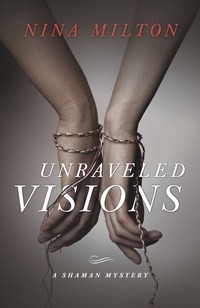 But John knew what he was saying. For me, things were never the same again.
But John knew what he was saying. For me, things were never the same again.
John reminded us that although shamanism can be a spiritual path, from its very early beginnings, it has been used as a tool; a method of getting close to another world – the world of spirits. It’s a very ancient practice indeed; there are those who think shamans are depicted in the Neolithic cave paintings found all over Europe. Shamans are thought of as special people by the communities they function within. By entering a trance, often using nothing more than a drum beat or the rhythm of a dance, they move between the solid world we all live in, and the otherworlds, bringing back answers to questions that have no answers.
It is said that to become a shaman, one must be called by spirits, but I think the spirits are calling us all…it’s just that only some people listen. When I talked to the other work-shoppers that weekend, I found several who described having the ‘shaman’s sickness’, a health crisis that had brought them visionary dreams. Other had found their minds opening during a ‘vision quest’ in wild country or during a dark night.
“The rainbow path of the seeker takes you from your own world to the inner-worlds,” John advised. “You will become walkers between the worlds.” We lay down, scarves or sleep masks over our eyes, and listened to the singing tone high above the beat of John’s bodhrán and let our imagination take us along the rainbow path to the otherworld.
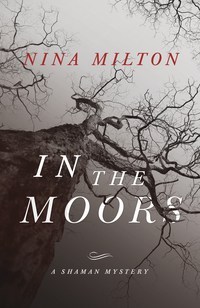 The more I delved, the more fascinated I became. By closing my eyes, listening to a fast, regular drum beat and allowing my mind to steady and focus, I found I was able to walk between the worlds, accompanied by my spirit ally who came to me in the guise of a mole, able to burrow down into lower realms. When I stroked his back with one finger, his coat felt as soft, warm and sleek as any mole of this world. Mole and I would come upon otherworldly presences who spoke to me, either in perfectly normal conversations or in mysterious symbols and signs. They often advised or directed me, or offered a gift of significance. I’d emerge feeling refreshed…amazed.
The more I delved, the more fascinated I became. By closing my eyes, listening to a fast, regular drum beat and allowing my mind to steady and focus, I found I was able to walk between the worlds, accompanied by my spirit ally who came to me in the guise of a mole, able to burrow down into lower realms. When I stroked his back with one finger, his coat felt as soft, warm and sleek as any mole of this world. Mole and I would come upon otherworldly presences who spoke to me, either in perfectly normal conversations or in mysterious symbols and signs. They often advised or directed me, or offered a gift of significance. I’d emerge feeling refreshed…amazed.
I worked through Caitlin Matthew’s series of practitioner workshops, and I’ve since worked with other respected shaman too, building up my skills, and using them to some degree in my work as a palliative care nurse, and also for my own self-development. I loved the way this secret, rainbow world was mine to visit, enjoy and learn from at all times.
I was already a writer. In fact, I think I’ve always been one, ever since my first infant school teacher, Mrs Marsden, read an animal fable to the class, then asked us to write a similar sort of story. I was dumfounded – for the first time I understood that the books I loved had actually been written by real human beings. Before that, I believed they must have fallen from some sort of story heaven. It was a revelation – from then on I was scribbling down stories all the time.
Sometime after I’d been practicing shamanism in work and for myself, a new fictional character walked into my head.
“Hi,” she said. I was driving to work, at the time, and she seemed almost to plonk herself down on the passenger seat. “I’m Sabbie Dare.”
She looked like a woman in her late twenties, of mixed race, with a cute little gap between her front teeth and very long, almost black hair, which kinked as it fell. “I’m a shaman,” she went on. “A therapeutic shaman.”
“Ah, I responded,” (in my head, and keeping my eyes on the road, of course), “you take clients with problems. Probably problems they’ve already seen a gamut of professionals about; doctors, herbalists, even hypnotherapists.”
She’d nodded. “Some have souls that are complete shattered. And some bring me some very difficult problems. They are people on the edge.” I felt guided to write about Sabbie Dare – I became obsessed about her life and thoughts. She was like my younger sister.
The books are set on the Somerset Levels, a place with a truly fay and mysterious atmosphere, which can turn tricksy and dark, when mists come down, or floods rise, and I use the most isolated, desolate spot on the moors for the first Shaman Mystery, In the Moors. Things get very scary indeed for Sabbie, as she tries to help a client in trouble. She’s a girl who only wants the best for those she meets, and she’ll regularly put herself on the line, not only in the spirit world, but also in the apparent world, because The Shaman Mysteries, published by Llewellyn’s Midnight Ink imprint, are thrillers, albeit with an edge of spiritually.
I write them for pagans and crime fiction lovers alike, so I have to be careful to walk a line between the truth of my own spiritual path and the story I’m creating. I don’t want to spin a line, suggesting shamanism can ‘solve crime’ or ‘get people out of trouble’.
The otherworld rarely gives a direct answer – any shaman knows that. When Sabbie finally unravels the tangle of symbols and auguries her spirit world shows her, she’s never presented with a simple answer. Instead, she’s led to the place or moment where those answers will be best revealed. Unfortunately for Sabbie, those are the places of most danger. Sabbie knows this, but walks towards them anyway, because she’s passionate for her clients, and for justice – and she can’t help being insatiably curious!
As the series progresses I’ve introduced some of the aspects of shamanism and paganism that might enlighten the ‘muggle reader’. Book one, In the Moors explains Sabbie’s job as a therapist, and describes her shamanic journeys, introducing her animal ally, an otter called Trendle. In the second book, Unraveled Visions, I begin to develop Sabbie’s otherworld associations, and her ritual life celebrating the celtic wheel of the year. Book three, Beneath the Tor, has a theme of transformation, including shapeshifting. I also introduce the reader to the lower realms of the otherworld. This book is set in Glastonbury, and it was my great delight to be able to use some of the legends of the Vale of Avalon.
Meanwhile Sabbie herself begins to understand who she is. She was brought up in the care system, after her mother died when she was six…she’s never known her father. As the books develop, she uses her shamanic pathways to find out more about her own past , including her maternal family, who are from Somerset, and her Caribbean father, who becomes her spirit guide.
I’ve never forgotten John Matthews’ claim that shamanism will change your life. It transformed mine, and I’d recommend pursuing the rainbow path to any pagan. Once you know how to access the world of spirits, you really never know what might happen next. What happened to me was that I now write books I love, and that people seem to love reading them. It was the one thing I’d longed to be able to do, and I am sure that the spirit world brought me this blessing.
 Nina Milton’s blogsite for readers and writers is http://kitchentablewriters.blogspot.com and she’s also on Facebook at The Shaman Mysteries and on twitter as @ninahare.
Nina Milton’s blogsite for readers and writers is http://kitchentablewriters.blogspot.com and she’s also on Facebook at The Shaman Mysteries and on twitter as @ninahare.


April 22, 2016
Travelling with Inanna
Last year I read Jane Meredith’s Journey to the Dark Goddess and became interested in the descent of Inanna as a way of exploring the processes of depression. I’ve spent a lot of time looking at the journey downwards, and the triggers for that downward journey. It’s taken me until now to properly grasp that while Jane Meredith’s book is as much concerned with ascent as descent, I’ve not looked at how I come back at all until recently.
Inanna is stripped of everything as she descends. Physical items that are symbols of power and self are taken from her. Then, after her time on the meat hook, she comes back up, and the things taken are returned just as systematically. This is the point at which the story ceases to work as a metaphor for depression. Many of us go down due to external factors – losses, setbacks, dealing with shitty people. We are not automatically given back what was taken. We either have to do without it, make it, or find it elsewhere.
I crash every six to eight weeks, to some degree. I’ve been in a cycle of collapse and return like this for many years. Paying close attention to the triggers of falling into depression, and the process of depression once in it, has not stopped me continually burning out. I know more than I did, and I’ve been able to reduce the magnitude a bit, much of the time, but that’s all. So it’s been time to look at ascent. When I’m so tired I can’t think or move, when everything hurts and there seems to be no point even trying, how do I get going again?
The answer is rage. What gets me up, every time, is fury with myself over how stupid, useless and unreasonable I’m being. The people around me deserve better. There are things that have to be done and I’m not doing them because I’m huddled in a corner, whimpering. I’ll call myself lazy, selfish, self-indulgent, a good for nothing waste of space, and I’ll batter myself with this language until the rage against myself is powerful enough to get me moving again.
I suspect there’s a direct relationship between this process, and the next round of falling over. It’s taken until now to question it, because until this month, the self-hatred that keeps me moving had seemed like a perfectly natural and reasonable thing. Feeling like my only point is my utility, and having internalised a sense of worthlessness a long time ago, I’ve had no way of being kind to myself in times of burnout. I haven’t felt I deserved being kind to, and I’ve had no way of fixing that alone.
When all you can change in response to a problem outside of you, is something inside of you, the options are limited. Depression is treated as an internal problem to be solved internally, but if it’s being caused by external issues, there’s a limit to what can be done. Problems that eat away at sense of self, self esteem, hope, and energy are not fixed by taking a positive attitude to them, especially if you have no means for being positive. Rewiring the longstanding thought patterns in a brain is not a quick or easy process. They aren’t fixed by anger, either. Sometimes, the change really has to come from other people. Sometimes, I need to ask for help, or to feel safe explaining the problem. Sometimes I need looking after.
I’ve made a few tentative forays into talking about what I need to have be different. I’ve sought a few changes from other people. I’ve worked out what, externally, is knocking me down and I’m trying to minimise contact with situations that take me apart. I am not a goddess in a mythical descent, but that doesn’t mean I can’t have the things taken given back to me.
Currently I’m working on how to get up gently. I’m ever more convinced that treating depression as individual and internal is part of the problem. The more time we spend collectively knocking each other back (or letting our politicians knock us back) the worse it gets. I think we can help each other to do something totally different.


April 21, 2016
Judging and Being Judged
The conventional new age spiritual wisdom is that judging is doing us no good at all. The more we judge others, the more likely we are to fear they are judging us. Competition is also suspect from a spiritual perspective. Judging is what gods do to us, and too often what we undertake to do on behalf of those gods when we don’t find them actively judgmental enough. So here I am, having judged and been judged. In both cases it related to short stories. On Saturday the 24th April 2016, we gather in Stroud for the readings of ten stories picked from nearly a hundred. For the second time, I’ve been one of the judges. I also just shortlisted for Evesham Short Stories.
It’s a very exposing thing, putting yourself forward to be judged. Creativity tends to feel really personal, and people can get hurt when their work isn’t chosen. It takes courage to come back year on year and try again – which many people do. For those who win, being judged is a massive boost, a validation and an encouragement. For those who don’t win it can be an equally big emotional setback.
Whether we want it or not, everything we do is judged. Is it adequate? Is it pleasing? From how we present our bodies to the world through every detail of what we do in those bodies, we are subject to other people’s judgements. Everything we test by doing it can lead to the discovery that we weren’t as good as we thought we were.
For creative people, every comment and review, every sale or nonsale is a reflection of the work, usually. We live dependant on the judgement of others, cut to shreds by the one negative remark even if it was a drop in an ocean of compliments.
For me, this whole business of contest and judgement can be approached as a more spiritual and philosophical issue. If I enter something, I have to be ok with the idea of not winning. I have to recognise that I might not win, and not pin my whole sense of self to the process. If I win, I have to keep it in perspective and while I will certainly feel delight or dismay, I try not to be too overwhelmed either way.
In the judging, of course I too will be judged. There’s every scope for authors who did not win to decide the problem was really my poor judgement. That I was too stupid and inexperienced to see the absolute genius of their story.
I’m sceptical about the idea that non-judgement is always the best thing. The act of selection gives us an evening of very fine stories. I’m perfectly happy with open mic sessions for all kinds of things, where people bring what they’ve got, but if you aren’t allowed to select, that’s all you can ever have. While judgement may not always be fair, and often has an arbitrary element (choosing ten good stories, when the 11th was also superb) it creates the space for celebrating what’s good and encouraging it. It’s not a perfect system, no system is.
Many of us are deeply motivated to strive for excellence; competitive spaces are a great asset for this. Many of us are not competitive and need safe places to explore and express ourselves. There has to be room for both, and I think in practice most people would benefit from doing both. We have to be able to lose, and we have to be easy with being one good bard amongst many. The person who declines to compete may just be persuading themselves that they’d have won everything, and that approach does a person no good at all.


April 20, 2016
Notes on a Filthology
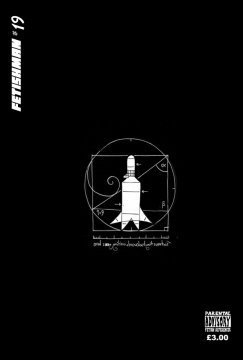
A Fetishman comic cover, not the Filthology.
Yesterday, Fetishman came through my letterbox. It’s ok, we’d paid for this to happen…
Feitshman is the creation of Dr Geof, and brings together two forms of writing of which I am not unfond. The Superhero genre, and BDSM. As a child I was a huge Batman fan, and I trace my enthusiasm for BDSM and fetish fiction back to that as well. The masks and costumes, the contrived scenes around capture and violence. While I have huge issues with how this genre depicts women, and with the samey plots, I still feel nostalgic. I spent some years writing filth myself, and gave up largely because I’d run out of ideas and was getting surreal to the point of dysfunction. I digress.
There are a great many things to love about Fetishman. For a start, there’s little that is graphic or detailed, although there’s seldom much doubt as to what’s happening. Almost all of the filth is implied, so it’s down to the reader to fill in the gaps with their own knowledge. Anyone capable of smirking at the idea of filling in some gaps for themselves, will be fine.
There’s a huge and important political aspect to the whole thing. Dr Geof is a clear supporter of the idea that consenting adults ought to be allowed to get on with it. He demonstrates the obscene double standard in our current laws – call it erotica or porn and you can fall foul of some pretty tight anti-extreme porn legislation. There’s lots of things that, even in a cartoon, it would be risky to depict. But, call it educational, or horror, and we’re good. Consenting genital masochism is bad, depictions of abuse and dismemberment are fine within this arrangement. Which sucks.
I’ve been seeing this double standard in books for too long. If it’s literature; incest and bestiality are no problem at all. The same content, in the erotica section is filth that must be banned. And before you conclude that really it’s about the low quality of writing in the erotica genre, it isn’t. Some smut is brilliantly written, some literature is pretentious wank. What it comes down to is that we’re allowed to describe or show outrageous things in intimate detail only if we pretend that no one could possibly be getting a sexual kick out of it. This strikes me as deeply unhealthy.
On the other side of this, we’ve got a culture that really doesn’t care as much as it should about consent. Victim blaming, slut shaming, the idea that non-consent can be sexy (50 Shades anyone?) the constant use of the female body to sell products and the likelihood this creates of seeing sexualised females bodies every day, regardless of whether you want to. What if we lived in a world where what happened between consenting adults was considered fine, and we were horrified by non-consenting situations. How different that would be!
Fetishman, it must be said, is all about consent. It’s also all about filth, fetish, ridiculous scenarios and a man who largely fails to fight crime because he’s wearing a restrictive fetish suit. It’s very funny. The Filthology brings together ten Fetishman comics, plus lots of lovely extras. I read it over the last two evenings, laughed a lot and felt better about life.
More about Fetishman here – http://fetishman.co.uk/


April 19, 2016
Paths of peace and conflict
It’s human to disagree, and inevitable some of those disagreements will become serious. On the other side, peace, and conflict resolution are generally offered as part of a spiritual path. We are to practice love, compassion, and reconciliation. One of the things I have learned over the years is this only works if both parties want to resolve and reconcile. If you’re dealing with a user, a power seeker, an abuser or someone else of unpleasant inclinations, reconciliation just opens the door to more hurt.
I’ve come to the conclusion that the only way to decide if reconciliation will bring peace, or further wounding, is to examine the price tag. There is always a cost to making peace with someone else. Some costs are perfectly acceptable – admitting any way in which you were genuinely in the wrong, for example. Sometimes we have to recognise that other people mess up for reasons, and they aren’t awful people even if they did something hurtful. We’re all learning, we’re all finite, we all make bad calls, or don’t know enough and so forth. If the price tag is that you just let go of this and give the person a second chance, because they’re sorry and it seems genuine, it’s a fair price to pay.
Sometimes the price tag is a painful working through of what went wrong and why. When mistakes or issues on both sides collide to create a problem, unpicking can hurt, but is possible, and is often worth going through because so much can be learned from it.
Other price tags are available. When you’re going to have to be really sorry, and really repentant, and have that wrong thing you did brought up over and over, reconciliation is expensive. When you think there’s shared blame, and other person will only accept making you responsible, reconciliation is hard, and perhaps futile. When you feel deeply hurt, or wronged, and your pain is treated like an attack on the other person, reconciliation can be dangerous. Being pressured to accept the damaging behaviour of someone who has more power than you, is dangerous.
If you’re in the wrong, there should be space to explain how you see things – many of us make innocent mistakes for honest and human reasons. Room to explain is important, especially if you’re going to accept responsibility, not deny it. If the mistake is honest, then the price tag of acceptance should lead to a much more comfortable situation and viable ways forward. If it doesn’t, ask questions.
Real reconciliation not only deals with the immediate conflict, but reduces the scope for conflict ahead. This is to be welcomed. Peace for the sake of peace can be really short term, sowing the seeds for the next round of conflict. Peace can allow perpetrators of unpleasantness to carry on unchallenged. It can increase the vulnerability and suffering of victims. When we can make peace with each other’s foibles and short comings, the world is a better place. When making peace allows the bad stuff to continue, the desire for peace becomes part of the problem.


April 18, 2016
Bird songs of abundance
The dawn chorus happens all year round, but is paid most attention to at midsummer, when the singing is at its peak. Even in winter though, there are some gestures towards an extra bit of song first thing, but it’s proportional to how much less singing happens at the colder time of year. Singing evidently takes both time and energy, and thus there’s more of it when the days are warmer and food in more plentiful supply.
My relationship with the dawn chorus is also seasonal and depends on temperature – if it’s warm enough to have the window open at night, I’ll wake then they sing. Many birds start well ahead of the light, which I find interesting – even as the day lengths are constantly changing, they know when to get started to sing up the sun. Like them I will wake ever earlier as we head towards midsummer.
I miss the singing in winter. It’s a sign of the move to spring when I start hearing the blackbirds again at twilight as well. At the moment, the woods are alive with song through the day – it’s a busy time, with chicks in nests. I can tell from the beaks full of food flying past that a lot of eggs have hatched already.
We’re not unlike birds. Folk music is full of songs for when you’re working. I imagine that pre-industrialisation it was a lot more normal to sing as you went. Song establishes connections between people, I have found, and I think the science is with me on this. Singing affects our minds and emotions, but it’s a lot harder to get your voice working well from a place of grief or despair. We sing to celebrate, when we have the spare energy, when things were good, and sometimes, just because we survived.


April 17, 2016
What is Druidry For?
Permit me the indulgence of starting with a strawman. The sort of Druid for whom Druidry is lovely, because nature is lovely, and everything is love and the universe is lovely and everything happens for the highest good and for a reason and by the way did I mention, it’s all lovely? Not entirely a strawman because these ideas do exist. The lovely Druidry of just getting to say how lovely it is, how lovely we are. Would you like some lovely sauce on that? Lovely.
It doesn’t work for me. Yes, the rainbows and sunsets are charming, yes the bird song is exquisite and I see all of this. I also see the road kill, the plastic rubbish in the streams, and the dead look too many people have in their eyes. Poverty isn’t lovely. Sickness isn’t lovely. I don’t think the universe loves us, benevolence is certainly not a given.
And then there’s the small matter of the Celts. Everything I know about the Celts tells me that they were a wild, passionate, creative, intense sort of people, willing to fight to the death over a matter of honour. In the art and the stories, in the traditions that seem to have come from there over the centuries, I see passion. Rage and jealousy exist alongside overwhelming love. Lust is as important as romantic attachments in terms of causing things to happen. And yes, we have reason to think of the ancient Druids as wise peacemakers and knowledge holders in this culture. It would be ridiculous to think that they held wildly different values from those around them, though.
For me, Druidry is about how to live well in a tradition that is full blooded, life embracing and passionate. It’s not about withdrawing from the world to a state of perfect calm. It’s not about taming emotions into submission. The Celts were a tempestuous, fighty people (in so far as it is fair to even use the word ‘Celt’ to represent a vast array of tribes over a long period, but, it saves time, so please indulge me). For this life to be viable, there must be balances, co-operation, times of harmony and productivity. We can’t all spend our entire time having fiery Celtic warrior meltdowns because we felt insulted. Pride and honour, necessity and responsibility all have to be balanced up, and for me, entering into a nature-based path of spirituality and philosophy is about learning how to do this well.
There should be times to be boastful and riotously drunk. There should be times when we react with fury and fight tooth and nail for honour and for what is right. There should be times for deep reflection and introspection. I want a life that embraces these things, not something harmless, bloodless, toothless that can only say ‘well, that’s lovely, isn’t it?’


April 16, 2016
Folklore, myth and new writing
All three of the titles in this set of reviews have a really interesting relationship with folklore and mythology.
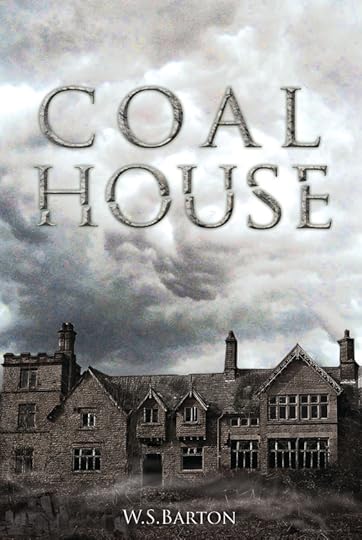 Coal House, W.S. Barton I came to quite by chance through a Twitter conversation. It’s a really creepy ghost story, with high levels of tension but not a lot of gore. I couldn’t put it down and read it in one evening. I can definitely recommend it. A haunting landscape, and a great plot. The folklore role in this is really interesting. A couple buy an empty house on impulse. Then the local people start being weird at them, but no one wants to talk about it. There’s some dark and troubled folklore associated with the house, but people seem reluctant to take it too seriously, until the deaths start again… everything anyone needed to know was there in the local folklore all along, but people coming in from further afield, and people not wanting to seem superstitious keep that valuable information out of the mix for too long. Given how well, and how long important information can survive in oral tradition, there’s something very pleasing about the way spooky tales do tend to validate the folklore while the people who sneer tend to be eaten first.
Coal House, W.S. Barton I came to quite by chance through a Twitter conversation. It’s a really creepy ghost story, with high levels of tension but not a lot of gore. I couldn’t put it down and read it in one evening. I can definitely recommend it. A haunting landscape, and a great plot. The folklore role in this is really interesting. A couple buy an empty house on impulse. Then the local people start being weird at them, but no one wants to talk about it. There’s some dark and troubled folklore associated with the house, but people seem reluctant to take it too seriously, until the deaths start again… everything anyone needed to know was there in the local folklore all along, but people coming in from further afield, and people not wanting to seem superstitious keep that valuable information out of the mix for too long. Given how well, and how long important information can survive in oral tradition, there’s something very pleasing about the way spooky tales do tend to validate the folklore while the people who sneer tend to be eaten first.
More about the book here – http://www.rudlinghouse.com/books/fiction/coal-house-by-w-s-barton/
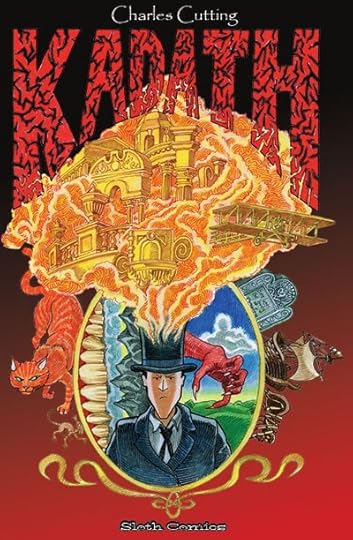 Kadath, Charles Cutting is a graphic novel published by Sloth (Hopeless Maine has moved to this house). Its a tale that both operates within and cunningly subverts the Lovecraftian mythos. I think what’s happening with Lovecraft is a fascinating case study in modern myth making, and Charles has certainly added to the mix. Based on The Dream Quest of Unknown Kadath, is makes explicit that the main character from Lovecraft’s story is really Lovecraft himself and brings to the fore all the detestable things about the man. It’s no mean feat to make a story viable with a loathsome main character, but it works – not least because it’s visually so appealing. Set mostly in the realms of dream, it shows a dreamworld that seems more like Dunsany than Lovecraft, and is enchanting. Carefully avoiding any spoilers, this is on one level a moral tale about people who obsess about the wrong things, and creative souls who are more enchanted by their own egos than by anything… well… enchanting. A remarkable and gorgeous piece of work, highly recommended.
Kadath, Charles Cutting is a graphic novel published by Sloth (Hopeless Maine has moved to this house). Its a tale that both operates within and cunningly subverts the Lovecraftian mythos. I think what’s happening with Lovecraft is a fascinating case study in modern myth making, and Charles has certainly added to the mix. Based on The Dream Quest of Unknown Kadath, is makes explicit that the main character from Lovecraft’s story is really Lovecraft himself and brings to the fore all the detestable things about the man. It’s no mean feat to make a story viable with a loathsome main character, but it works – not least because it’s visually so appealing. Set mostly in the realms of dream, it shows a dreamworld that seems more like Dunsany than Lovecraft, and is enchanting. Carefully avoiding any spoilers, this is on one level a moral tale about people who obsess about the wrong things, and creative souls who are more enchanted by their own egos than by anything… well… enchanting. A remarkable and gorgeous piece of work, highly recommended.
More about the book here – http://www.slothcomics.co.uk/kadath.html
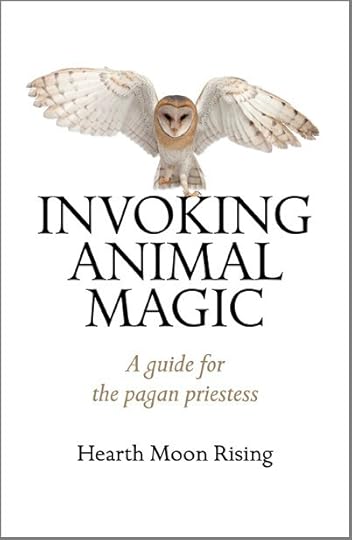 Invoking Animal Magic, Hearth Moon Rising. This is a book offered as a study text for would-be students of animal magic. I confess I didn’t read it that way, not being someone who is looking for study options at the moment. I read it instead as a fantastic collection of myths, folklore, and personal insights relating to a set of creatures. Hearth Moon Rising has picked out a selection of creatures with particularly rich and magical folklore and explored the differences and similarities in tales from around the world to help the reader connect with these various beings. I especially like the way that there’s no attempt to shoehorn international folklore into single narratives, and that the diversity in stories is kept really visible. The tales are brilliant, and shared with considerable wit, wisdom and insight. It was an absolute joy to read. I suspect it’s a great study course, but if you aren’t looking to practice, it’s well worth having for the stories, and everything you can learn and enjoy in them. As it’s an illustrated book, I recommend getting the paperback – an ebook won’t do the visuals any justice at all.
Invoking Animal Magic, Hearth Moon Rising. This is a book offered as a study text for would-be students of animal magic. I confess I didn’t read it that way, not being someone who is looking for study options at the moment. I read it instead as a fantastic collection of myths, folklore, and personal insights relating to a set of creatures. Hearth Moon Rising has picked out a selection of creatures with particularly rich and magical folklore and explored the differences and similarities in tales from around the world to help the reader connect with these various beings. I especially like the way that there’s no attempt to shoehorn international folklore into single narratives, and that the diversity in stories is kept really visible. The tales are brilliant, and shared with considerable wit, wisdom and insight. It was an absolute joy to read. I suspect it’s a great study course, but if you aren’t looking to practice, it’s well worth having for the stories, and everything you can learn and enjoy in them. As it’s an illustrated book, I recommend getting the paperback – an ebook won’t do the visuals any justice at all.
More about the book here – http://www.moon-books.net/books/invoking-animal-magic


April 15, 2016
Druidry and Life Stages
When asking ‘what is Druidry?’ it may be useful to ask ‘what is Druidry to me now?’ It doesn’t mean what it meant fourteen years ago when I started studying in earnest. Back then, Druidry meant learning, above and beyond all else. I was ambitious, and hungry, and determined. I was also relatively young and I think these qualities are natural enough in youth.
For a decade or so, my personal Druidry was almost entirely about the bard path. I balanced this with work for community groups, and facilitating community ritual. Celebration and communication were key themes.
Then I became a bit of a hermit for a while, and communion became more important to me. Themes of contemplation and wandering began to emerge because I couldn’t deal with people. I became interested in the ancestors, and the spirits of the land.
I changed again, for a year of being a public facing activist, and for a while my Druidry was all about politics and serving the wider community. I burned out, and stepped back.
At the moment I’m trying to find balance between hermit-hood and participation, contemplation and action, and it is walking that is the heart of my personal practice. Next year, who knows?
How I practice is influenced by what I’ve learned, by my energy levels, and mental/emotional needs. I probably looked far more like a Druid when I started out, when a daily practice meant obvious acts of ritual. I have no idea what I look like these days and I mind less – far less ambitious, and differently driven.
The Druidry of my twenties could not be the Druidry of my thirties, and no doubt my next decade will bring new shifts in direction. We have to give ourselves room and permission to change; to pick up things we’ve previously rejected, to change our minds, and to want differently. Seeking to carve a definition of our Druidry in stone, all we do is give ourselves an inconvenient stone to heft about. I’m not sure ‘What is Druidry’ is a useful question (I used to think it was, perhaps it will be again). Right now, the question of ‘what is my Druidry right now’ seems far more important. Also, what does other people’s Druidry look like? What can I learn, how can I negotiate with the differences and how can we co-operate as we co-evolve?


April 14, 2016
If prayer is awkward
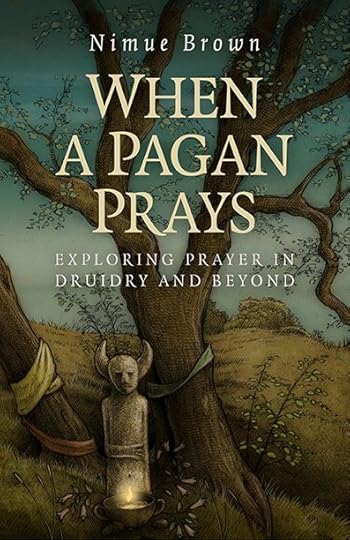 Some Pagans find prayer an easy and natural part of their practice. I’m the other sort. I spend a lot of my time writing about things I find difficult, because I find it makes for more fertile explorations. It’s not the easiest sales pitch in the world though! I can’t solve all your problems, there won’t be an easy five minute solution, but if you’re uneasy too, and uncertain, and wondering, then wander with me and maybe something will happen.
Some Pagans find prayer an easy and natural part of their practice. I’m the other sort. I spend a lot of my time writing about things I find difficult, because I find it makes for more fertile explorations. It’s not the easiest sales pitch in the world though! I can’t solve all your problems, there won’t be an easy five minute solution, but if you’re uneasy too, and uncertain, and wondering, then wander with me and maybe something will happen.
Here’s a snippet from When A Pagan Prays.
What is prayer? Prayer is something that people do as a manifestation of religion or as part of a spiritual practice. Beyond that, it is remarkably difficult to pin down, being a term for a vast array of activities. Prayer crops up in religions across the globe, but what exactly it is, and how it works, depends a lot on who is doing it in what context, and why. Prayer runs the full gamut from insidious control method to means of enlightenment. I’ve tried to unpick how some of that works.
As with most things, what you get out of prayer depends a great deal on what you bring. The reason you undertake prayer is going to influence what happens to you. If you are a lovedrenched tree-hugging pacifist, your prayers will probably be full of love and light and at the very least, more feel-good affirmations. If you are a person in pain, or full of anxiety, you’ll pray differently, but that’s no less meaningful. People coming to prayer out of curiosity, a desire for mystery, a hunger for connection, can do all kinds of good work. If, on the other hand, you are a fascist control freak with a desire to torture puppies, you aren’t going the enlightenment route this week and the experience of prayer will probably just reflect your own fantasies back at you.
Mostly what we bring to prayer, is us. Mostly what we do in prayer, is us. If we want to reach out to the cosmos, or some aspect of it in an honourable way, we’ll do that thing. If we want to justify our own greed and bullshit, prayer is a tool to be used.
Dear God, I’m good!
If you are intent on being self-important, are deaf to all criticism and blind to the suffering of others, prayer will not help you much. You get what you bring. If you are willing and able to be open, vulnerable, listening, if you are here to be changed, that’s a very realistic possible outcome, no matter which
tradition you follow or the methods you adopt.
More about the book here – http://www.moon-books.net/books/when-pagan-prays





